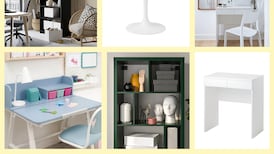Construction and material costs have risen dramatically over the past year, making budgeting for a home renovation more challenging than ever. It’s often the decorative elements that get sacrificed to keep the budget on track and lighting tends to be one of the first casualties. However, lighting is such an important design feature, critical to creating the right atmosphere in your home. I chatted with lighting expert Willie Duggan jnr from Willie Duggan Lighting to find out how to achieve maximum impact with lighting without breaking the bank.
Less is more
Use downlights sparingly and in the right locations. Recessed spotlights or downlights have become the go-to lighting solution but they are not always the best choice. “Rooms are frequently over-lit,” says Duggan. “We often see the scenario where there are downlights everywhere when many are not needed,” he says.
You don’t need to pepper the ceilings with downlights. When planning a lighting scheme, look at each room and minimise the number of downlights. The best way to do this is by placing them in precise locations, only where they are required, such as over the work surface in a kitchen.
Being more considered in your approach will also allow you to focus on using better quality fittings that will last and perform better, saving money in the long run. It will also reduce the number of wiring points you need, giving you a saving on the installation.
READ MORE
Plan
Getting the right advice in the early stages of your project can save you money and early expert input will guide how best to use your budget.
Planning ahead will also mean you’ll have time to get things priced and make decisions at your own pace. Making decisions when your electrician is on site can be difficult and stressful. Quite often, with aesthetic choices, you need time to mull them over. It can be almost impossible to make a good decision under pressure. Being prepared will mean you’ll know what you want to do when the work starts and, most importantly, you’ll have peace of mind you are making the right decisions.
Take your time
Don’t put yourself under pressure to have everything finished straight away. For example, pendants can be fitted later if the budget isn’t available for the fitting you want. Install the wiring point and fit an inexpensive temporary fitting or blank off the cabling until later.
Sometimes, allowing things to evolve yields a better result. By taking your time, you’re more likely to invest in a quality fitting that will last rather than buying something that may end up in a skip.
The most important consideration is ensuring the cables are in the correct position. The fitting itself can come later. Realising you put a cable in the wrong place and trying to change or add in a fitting later can be messy, disruptive and costly.
Prioritise
Try to prioritise where you spend your money. “You can work to most budgets and still create good bang for your buck,” says Duggan. You might decide to invest in the areas you’ll be spending a lot of time in, such as the kitchen, and pull back in other rooms. But even in spaces where you are looking to cut back, it’s possible to achieve an attractive result cost-effectively. In a bedroom, for example, using a drum pendant with a diffuser and some beautiful bedside lights is a lovely and inexpensive way to create a gentle and relaxed atmosphere.
LED tape
LED tape can be used for hidden lighting and is a cost-effective way to add atmosphere and impact to your home. A 5m roll costs about €500. It can be used to wash walls with light or as an accent light source in a wall or ceiling recess. It can also be used in built-in joinery to illuminate shelving or as feature lighting along skirtings. The builder will need to create the recess to hide the light strip, so it’s advisable to consider these details early in the design process.
Energy
LED bulbs are five to 10 times more efficient than older bulbs so make sure all the bulbs in your home are LED. This easy swap will save you money straight away.
Sensors that turn the lights on only when someone is in the room are good, but only in specific spaces. For example, they can be problematic in living areas as they keep the lights on only if someone is moving around. They are better suited to cupboards, pantries or wardrobes.
There are lots of portable Bluetooth and wireless lamps available. Designed for ambient lighting, they are ideal when you want to add a light for atmosphere but don’t have a power source. They can be moved easily from room to room, and many fittings are suitable for indoor and outdoor use. They are not ideal for reading or task lighting as their output is typically 300-400 lumens (for reading, you need about 600-700). However, technology is moving quickly so expect significant advances in this area in the next few years.












